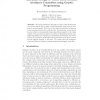550 search results - page 53 / 110 » A Design Process for Adaptive Behavior of Situated Agents |
RAM
2008
IEEE
14 years 3 months ago
2008
IEEE
Abstract—Nonverbal behavior during human-human close encounters is critical to the accomplishment of natural interaction. For this reason, humanoid robots trying to achieve natur...
HICSS
2010
IEEE
14 years 3 months ago
2010
IEEE
Current approaches to the design of interactive systems emphasize openness, dynamic behavior, and evolution of the system. There is also a growing interest in accounting for human...
CEC
2010
IEEE
13 years 9 months ago
2010
IEEE
For any embodied, mobile, autonomous agent it is essential to control its actuators appropriately for the faced task. This holds for natural organisms as well as for robots. If sev...
AE
2007
Springer
14 years 2 months ago
2007
Springer
The work presented in this paper is part of the development of a robotic system able to learn context dependent visual clues to navigate in its environment. We focus on the obstacl...
E4MAS
2004
Springer
14 years 2 months ago
2004
Springer
The environment is an important but overlooked piece in the construction of multiagent-based scenarios. Richness, believability and variety of scenarios are inseparable from the en...


